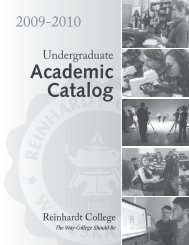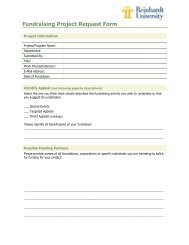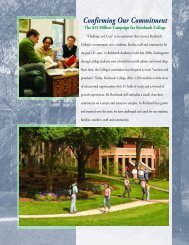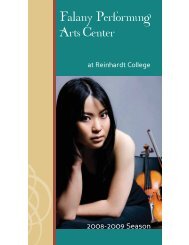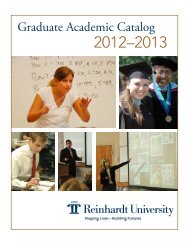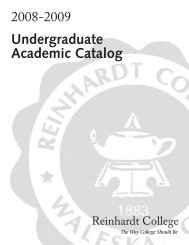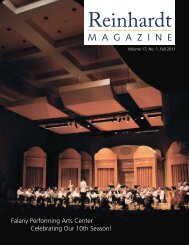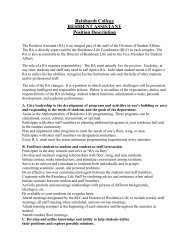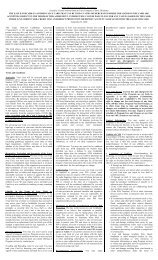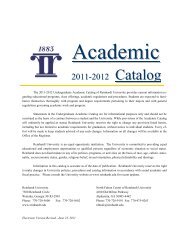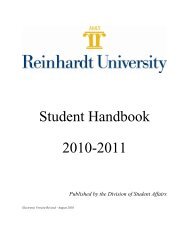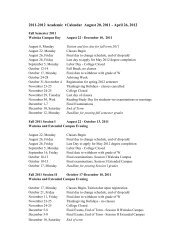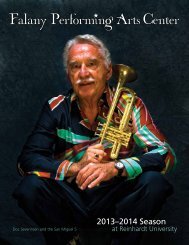On Aug. 28, 2010, the University welcomed some - Reinhardt ...
On Aug. 28, 2010, the University welcomed some - Reinhardt ...
On Aug. 28, 2010, the University welcomed some - Reinhardt ...
You also want an ePaper? Increase the reach of your titles
YUMPU automatically turns print PDFs into web optimized ePapers that Google loves.
Satre said small classes help students<br />
bond. “They are more active with study<br />
groups and more apt to talk outside class,”<br />
she said. Working toge<strong>the</strong>r successfully is<br />
critical in science, said Santoro. “Especially<br />
in research, you need to be collaborative,”<br />
she said. “You don’t do anything alone.”<br />
Students are also doing research. This<br />
October, students studied <strong>the</strong> deciduous<br />
forest that borders Lake Huron. Ano<strong>the</strong>r<br />
group went to Kentucky to collect salamander<br />
samples. “If <strong>some</strong>one wants to go<br />
to med school, we can give <strong>the</strong>m an advantage<br />
by spending time... with a research<br />
project and helping <strong>the</strong>m develop <strong>the</strong>ir<br />
critical thinking, writing and presentation<br />
skills,” Felix said. “Spending time with <strong>the</strong><br />
students; that’s our edge.”<br />
Students are also getting published. Last<br />
year, four students presented at an Association<br />
of Sou<strong>the</strong>astern Biologists conference.<br />
Posters are how younger scientists present<br />
<strong>the</strong>ir work, said Santoro. They create a<br />
graphical representation of <strong>the</strong>ir research,<br />
<strong>the</strong>n scientists and students come by and<br />
Left: Lee Lamb (left) and Taylor Barnes<br />
consult <strong>the</strong>ir notes as <strong>the</strong>y work on a dissection<br />
project.<br />
Below: Dr. Irma Santoro (left) enjoys continuing<br />
to teach students in actual labs.<br />
“At o<strong>the</strong>r places, instruction is moving<br />
more and more to computers. You don’t<br />
often see wet labs any more. You see schools<br />
doing genetic experiments on computers<br />
on virtual fruit flies. They sit in front of<br />
<strong>the</strong>ir own computer screens, by <strong>the</strong>mselves,<br />
not working toge<strong>the</strong>r. That’s not modeling<br />
how real science is done.”<br />
ask questions. The abstracts get published,<br />
and <strong>the</strong> posters qualify as <strong>the</strong>ir first formal<br />
publication.”<br />
Ano<strong>the</strong>r advantage is <strong>Reinhardt</strong>’s location.<br />
“Our environment, our campus, becomes<br />
part of class,” said Santoro. “We go<br />
look for bugs or down to <strong>the</strong> lake to get<br />
a water sample. That brings it toge<strong>the</strong>r. If<br />
you provide everything, it’s like a child who<br />
has no idea where fruit and vegetables come<br />
from because <strong>the</strong>y’ve never grown anything<br />
from a seed. Here <strong>the</strong>y can put <strong>the</strong> two toge<strong>the</strong>r<br />
because <strong>the</strong>y can collect <strong>the</strong> things<br />
<strong>the</strong>y’ll be doing <strong>the</strong> research on. The circle<br />
can become complete.”<br />
Growing Program Produces Needs<br />
As <strong>the</strong> science programs have grown<br />
and <strong>the</strong> faculty expertise expanded, more<br />
needs have developed. “Our group has<br />
been a point of excellence for 20 years, but<br />
we... haven’t had <strong>the</strong> staff or <strong>the</strong> facilities<br />
to support large numbers,” Robertson said.<br />
“Now we have <strong>the</strong> staff, and we’re pushing<br />
our physical boundaries in terms of space.”<br />
<strong>Reinhardt</strong> President Dr. J. Thomas Isherwood<br />
recognizes <strong>the</strong>se needs. “As we’ve<br />
expanded in <strong>the</strong> sciences, <strong>the</strong>re’s a critical<br />
need for more laboratories and more technical<br />
equipment,” he said.<br />
The faculty also need <strong>the</strong> resources to<br />
perform research. “These faculty have to<br />
do research in order to be qualified for tenure,<br />
but we don’t have <strong>the</strong> equipment <strong>the</strong>y<br />
need,” Robertson said. “We have <strong>the</strong> type<br />
of professors we want, and we need to support<br />
<strong>the</strong>ir research... Right now, we can’t.”<br />
A new science center is <strong>the</strong> top construction<br />
priority in <strong>the</strong> <strong>2010</strong> – 2015 Strategic<br />
Plan. The <strong>University</strong> is committed<br />
to raising $4 million to construct and furnish<br />
a building adjacent to <strong>the</strong> Samuel C.<br />
Dobbs Science Building. “We are looking<br />
for donors for this much-needed facility,”<br />
said JoEllen Wilson ’61, vice president for<br />
institutional advancement and external affairs.<br />
“The growth of this program, and <strong>the</strong><br />
success of <strong>the</strong> graduates are exciting, and we<br />
want to put <strong>the</strong> blocks in place to continue<br />
its success.” — MSW<br />
Living History<br />
Elree Bridges Worley ’48<br />
Writes About Her Childhood<br />
During <strong>the</strong> Depression<br />
<strong>Reinhardt</strong> alumna Elree Worley’s tales from<br />
her childhood during <strong>the</strong> Depression, “We<br />
Made It” and “Rounding <strong>the</strong> Corners,” have<br />
been compiled into one volume and re-released<br />
by Yawn’s Publishing in Canton, Ga.<br />
The first book, “We Made It,” was<br />
published in <strong>the</strong> early 1990s and contains<br />
more than 40 stories from her youth. She<br />
wrote <strong>the</strong> second book a few years later after<br />
readers asked for more tales.<br />
“People said, ‘You didn’t write anything<br />
about so and so’ and ‘You didn’t mention<br />
so and so,’” she said.<br />
Worley, now 86, would recount her<br />
childhood stories to her granddaughter,<br />
which eventually led to her decision to<br />
write <strong>the</strong> episodes down.<br />
“I could write better than I could<br />
talk,” she said, adding she has known she<br />
could be a writer since attending <strong>Reinhardt</strong><br />
for two years in <strong>the</strong> late 1940s. A<br />
teacher <strong>the</strong>re would read her work aloud to<br />
<strong>the</strong> class, she said.<br />
(Right) Worley demonstrates<br />
<strong>the</strong> string games she and her<br />
sister played while growing<br />
up in <strong>the</strong> Depression.<br />
(Top left) Worley points to<br />
her childhood photo.<br />
(Bottom left) Worley plays<br />
jack stones.<br />
Photos by Samantha<br />
Wilson, Cherokee Tribune.<br />
Read more: Cherokee<br />
Tribune - Rewriting<br />
History<br />
“If she liked it, maybe I could hatch up<br />
<strong>some</strong> stories,” she said.<br />
The book’s stories are about <strong>the</strong> “trials<br />
and tribulations” of everyday life during<br />
that era.<br />
Worley was one of 12 children. Her fa<strong>the</strong>r<br />
owned a country store, and <strong>the</strong> family<br />
raised cotton in a tiny community called<br />
Enterprise.<br />
Stories include “Saving <strong>the</strong> Chewing<br />
Gum,” where she recalls <strong>the</strong> luxury of<br />
chewing gum and how children would take<br />
gum out of <strong>the</strong>ir mouths only for meals.<br />
Gum would stay in a child’s mouth unless<br />
it dropped out <strong>some</strong>how and got “too<br />
much dirt to be cleaned off.”<br />
She also writes about milking cows,<br />
going to square dances and homespun<br />
fun and games. “Our parents couldn’t afford<br />
to buy us toys,” she said. “Children<br />
created <strong>the</strong>ir own games, such as collecting<br />
rocks from <strong>the</strong> yard to play jack stones,<br />
using string to form different shapes with<br />
our hands and spinning a button on a piece<br />
of thread.”<br />
“We would play it for hours,” said Worley.<br />
“Mo<strong>the</strong>r would get us to play it because<br />
it was quiet.”<br />
During <strong>the</strong> depression, she explained<br />
that children were not aware of <strong>the</strong> economic<br />
conditions. “Everyone was just<br />
alike. Everybody had <strong>the</strong> same nothing. We<br />
made it just as good as anybody else.”<br />
Worley, who is widowed, has three<br />
children and two grandchildren, and she<br />
is excited to see <strong>the</strong> stories reprinted so<br />
more people in <strong>the</strong> community can share<br />
in <strong>the</strong>m.<br />
“It is history,” she said. “True, everyday,<br />
living history.” –article by Ashley Fuller<br />
’01 for <strong>the</strong> Feb. 26, <strong>2010</strong>, issue of The<br />
Cherokee Tribune<br />
8 9



